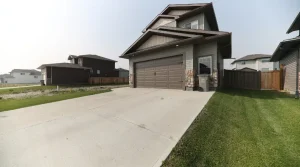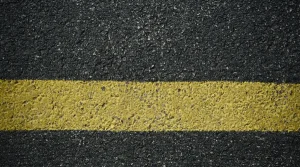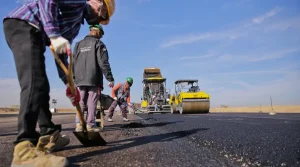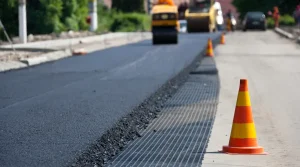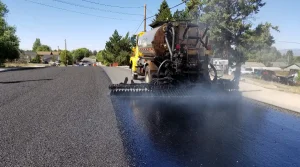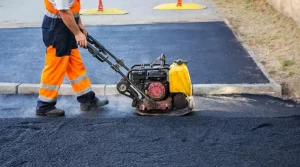Nothing looks better than a freshly paved asphalt parking lot. (Okay, we’re a little bit biased.) But asphalt maintenance on your driveway is key.
Freshly laid asphalt looks amazing, and it gives any parking lot or driveway a clean, modern, and upscale look.
If you take care of your new asphalt, it will stay looking nice and working well for 15 to 30 years. If you don’t do it, you could be looking at 5–7 years (Ugh!).
Asphalt is one of the most cost-effective and reliable ways to pave a road, but to keep it looking good and working well for as long as possible, you need to keep people from mistreating it and do regular maintenance.
Here are the most important things to do and not do when taking care of an asphalt parking lot.
HOW TO CARE FOR ASPHALT AFTERWARDS
DO GIVE YOUR NEW ASPHALT TIME TO CURED
You can drive on asphalt as soon as it is dry, which usually takes about 24 hours after it has been poured. But keep in mind that your beautiful new pavement won’t be as strong or resistant to damage as it can be until it has fully cured, which takes about a year.
Even though your parking lot will be usable during the curing process, it will be better in the long run if you take some precautions to avoid rough use and abuse.
During the first year after your new asphalt parking lot has been poured:
- monitor and limit the weight of the cars that drive on it,
- keep track of how long they stay in one spot, and
- tell drivers to slow down and drive safely (no donuts or drag racing!). The new surface will be damaged by peeling.)
DO CLEAN UP OIL AND FUEL SPILLS RIGHT AWAY.
There aren’t many things that can really hurt brand-new asphalt, but a spill of oil or fuel will do irreparable damage.
The chemicals that keep asphalt together are broken down by oil and gasoline.
What’s the worst? It can do this quickly, weakening the way your smooth, new asphalt is built. Penetration of the surface of the asphalt leads to raveling and even worse!
This will cause major problems with your pavement in the future, and you’ll have to do a lot of work to fix it. Stop damage as soon as possible! Browse around this site.
HOW TO CLEAN FUEL AND OIL SPOTS FROM ASPHALT PAVING
If oil or gasoline gets spilled on your asphalt:
- Soak up as much of the fluid as you can (sawdust and no-clump cat litter work well when left overnight)
- Take out as much of the oily cat litter or sawdust as you can and throw it away properly.
- Spray the area with water to remove any remaining debris. If all you want to do is get rid of loose dirt, don’t use pressure washing.
- Use a commercial degreaser, a tri-sodium phosphate (TSP) paste, or dish soap and water, and scrub it into the dirty area. Avoid cleaning up the spill with chemicals that contain solvents, as they could do more damage to your asphalt than the spill itself. Make sure your eyes and skin are safe during this process.
- Rinse the area well and set it aside to dry.
DO SLOW DOWN!
Speed kills asphalt, especially asphalt that has just been laid.
Take your time getting into your newly paved area so you don’t damage it. If you move more slowly, you won’t damage anything.
If you put down asphalt for the public to use, it’s best to slow down traffic in the area to avoid damage.
DO CLEAN UP THE SNOW AND ICE
Because asphalt is porous, it doesn’t do well with water when it’s drying.
During the winter, water can get in through the natural pores in asphalt.
If water gets into the holes in your asphalt and freezes, you have a problem. When water freezes, it gets bigger, so the pressure will build up under the surface of your asphalt paving.
This can lead to large cracks and holes in the road over time.
It’s important to use some kind of ice-melting product on your asphalt to stop water from freezing in it.
DO SEALCOAT REGULARLY
Apply a good sealcoat to your asphalt once it has fully hardened, but not before. Sealing asphalt keeps water from getting into it, keeps it from fading, and makes it last longer.
After the first sealcoating, you should have a professional do it again every 2 to 5 years.
THE DON’TS OF ASPHALT AFTERCARE
DON’T DRIVE ON FRESH ASPHALT FOR AT LEAST 24 HOURS
Don’t drive on asphalt for at least 24 hours if you want it to look good and stay stable. If you drive too soon on freshly laid asphalt, you could make ruts and holes. Water and debris will get trapped in ruts and dips, which will do more damage to your asphalt.
During the first 24 hours after laying asphalt, it is still pretty soft, so cars, trucks, and even motorcycles can easily damage it.
After the first 24 hours, it’s usually safe to drive on asphalt, but if you want to be extra careful, you might want to wait 48 or even 72 hours, especially in the summer when it’s hot and takes longer for asphalt to dry.
DO NOT LET WEEDS AND PLANTS GET OUT OF CONTROL.
Make sure there are no weeds growing along the edges of your asphalt paving. Weed roots can cause bumps and cracks in your pavement that will grow into bigger cracks and holes over time. To avoid problems in the future, pull up weeds by the roots and put weed killer along the edges during the growing season.
It’s easy to ignore small cracks in your asphalt, but this is a big (read “expensive”) mistake. Even small cracks can grow into big problems that need an expensive fix by a professional asphalt worker.
DO NOT IGNORE SMALL HOLES AND CRACKS IN YOUR ASPHALT
Keep an eye out for new cracks or small holes in your asphalt. Cracks should be filled with asphalt crack sealant, and holes should be fixed right away to keep them from getting bigger.
If you ignore the cracks in your asphalt, they won’t go away. If you don’t fix them, they will get bigger until you can’t fix them yourself. Check your parking lot at least once a month to make sure the asphalt is in good shape.
At Hackensack Paving, we pave asphalt, fix asphalt, and take care of asphalt for residential, commercial, municipal, and industrial customers.
Call (201) 514-6060 during business hours to be sure of getting a response the same day.
Contact us right now to get your free quote.


